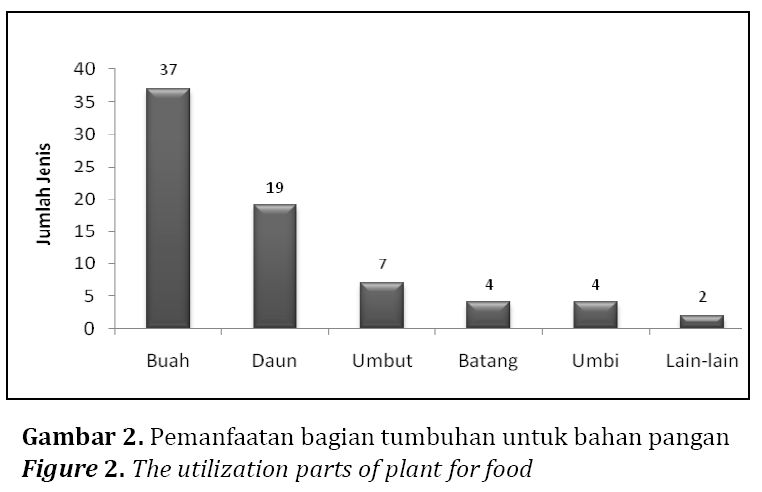Kajian etnobotani masyarakat adat suku moronene di Taman Nasional Rawa Aopa Watumohai

Downloads
The Moronene ethnic living in the forests of Rawa Aopa Watumohai National Park has strong interaction with nature and environment around the park. The interaction of indigenous people with their environment produced the wisdom to manage the natural resources for sustainable benefit. This study was aimed to comprehend various forms of plants utilizations by this local community. The method used is field survey, included interviews, plant identification and data analysis. The data was collected by semi-structured interviews with respondents. Plant specimen collection was conducted together with key informants. The data was analyzed with descriptive qualitative method. The utilization of plants by indigenous peoples of Moronene tribe is divided into three major groups, including for food, medicine and traditional ceremony. As much as 124 species, including 68 species for food, 65 species for medicine and 10 species for traditional ceremony were identified.
Abdiyani, S. (2008). Keanekaragaman jenis tumbuhan bawah berkhasiat obat di dataran tinggi Dieng. Jurnal Penelitian Hutan dan Konservasi Alam, 5(1), 79-86.
Anggana, A.F. (2011). Kajian Etnobotani Masyarakat di Sekitar Taman Nasional Gunung Merapi; Studi Kasus di Desa Umbulharjo, Sidorejo, Wonodoyo dan Ngablak (Skripsi). Fakultas Kehutanan. Institut Pertanian Bogor. (Tidak dipublikasikan).
Bonai, Y.M.M. (2013). Pemanfaatan jenis-jenis tumbuhan obat tradisional oleh masyarakat Suku Klabra di Kampung Buk Distrik Klabot Kabupaten Sorong (Skripsi). Fakultas Kehutanan. Universitas Negeri Papua. (Tidak dipublikasikan).
CIFOR (Center for International Forestry Research). (2007). Hutan dan kesehatan manusia. Info brief No.11(b). Jakarta.
Fakhrozi, I. (2009). Etnobotani masyarakat Suku Melayu tradisional di sekitar Taman Nasional Bukit Tigapuluh: Studi Kasus di Desa Rantau Langsat, Kec. Batang Gangsal, Kab. Indragiri ulu, Provinsi Riau (Skripsi). Fakultas Kehutanan. Institut Pertanian Bogor. (Tidak dipublikasikan).
Hamidu, H. (2009). Kajian etnobotani Suku Buton (Kasus masyarakat sekitar hutan Lambusango Kabupaten Buton Provinsi Sulawesi Tenggara). Skripsi. Fakultas Kehutanan. Institut Pertanian Bogor. (Tidak dipublikasikan).
Hasibuan, M.A.S. (2011). Etnobotani masyarakat Suku Angkola : Studi kasus di Desa Padang Bujur sekitar Cagar Alam Dolok Sibual-buali, Kabupaten Tapanuli Selatan, Sumatera Utara (Skripsi). Fakultas Kehutanan. Institut Pertanian Bogor. (Tidak dipublikasikan).
Hidayat, S. (2010). Etnobotani Masyarakat Kampung Adat Dukuh di Garut, Jawa Barat (Skripsi). Fakultas Kehutanan. Institut Pertanian Bogor. (Tidak dipublikasikan).
Ismanto. (2007). Inventarisasi Potensi Pakis (Cyathea sp) di Kabupaten Mamuju Provinsi Sulawesi Barat. Buletin Konservasi Alam, 7 (1): 48-56.
Kandari, L.S. Phondani, P.C. Payal, K.C. Rao, K.S. and Maikhuri, R.K. (2012). Ethnobotanical Study towards Conservation of Medicinal and Aromatic Plants in Upper Catchments of Dhauli Ganga in the Central Himalaya. Journal of Mountain Science, 9, 286-296.
Kumar, G.P. Kuma, R. and Chaurasia, O.P. (2011). Current status and potential prospects of medicinal plant sector in trans-Himalayan Ladakh. Journal of Medicinal Plants Research, 5, 2929-2940.
Mukherjee, P.K. dan Wahil, A. (2006). Integrated approaches towards drug development from Ayurveda and other systems of medicine. Journal of Ethnopharmacology, 103: 25-35.
Na'im, A. dan Syaputra, H. (2010). Kewarganegaraan, suku bangsa, agama, dan bahasa sehari-hari penduduk indonesia; hasil sensus penduduk 2010. Jakarta: Badan Pusat Statistik.
Nopandry, B. (2007). Hutan untuk masyarakat pemanfaatan lestari hutan konservasi. Buletin Konservasi Alam, 7 (1), 4-8.
Peraturan Pemerintah Republik Indonesia Nomor 8 Tahun 1999 tentang pemanfaatan jenis tumbuhan dan satwa liar
Saepuddin, R. (2005). Etnobotani pada masyarakat adat Kasepuhan Banten Kidul, Kabupaten Sukabumi, Jawa Barat (Skripsi). Fakultas Kehutanan. Institut Pertanian Bogor. (Tidak dipublikasikan).
Sunarti, S. Rugayah. dan Djarwaningsih, T. (2007). Tumbuhan Berpotensi Bahan Pangan di Daerah Cagar Alam Tangale. Jurnal Biodiversitas, 8 (2), 88-91.
Suryadharma, I. (2008). Diktat kuliah etnobotani. Jurusan Pendidikan Biologi. Fakultas Matematikan dan Ilmu Pengetahuan Alam. Yogyakarta: Universitas Negeri Yogyakarta.
Undang-Undang Republik Indonesia Nomor 5 Tahun 1990 tentang konservasi sumber daya alam hayati dan ekosistemnya
Zuhud, E.A.M. (2007). Sikap Masyarakat dan konservasi, suatu analisis Kedawung (Parkia timoriana (DC) Merr.), sebagai stimulus tumbuhan obat bagi masyarakat, kasus di Taman Nasional Meru Betiri (Disertasi). Fakultas Pascasarjana Institut Pertanian Bogor. (Tidak dipublikasikan).




